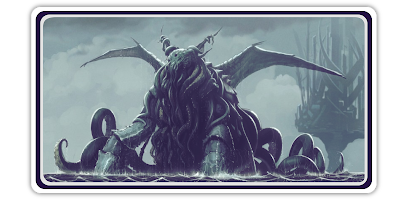6 Badass Monsters That Are Much Worse Than You Were Led to Believe
1. The Jabberwock, Through The Looking Glass (Lewis Carroll)

Yup, the description of the Jabberwock is exactly three lines long; it has eyes of flame, whiffles, and burbles when it moves. Doesn’t sound very scary, does it? But, if you read the whole poem and combine it with a little bit of imagination, what you can come up with can be terrifying. Knowing Carroll, it’s probably a safe bet to imagine it looking like a bad trip hallucination. Demonic insectoid clown, anyone?
2. Cthulhu and the Great Old Ones, The Call of Cthulhu (H.P. Lovecraft)

Here’s the interesting thing: more often than not, Cthulhu and the other Great Old Ones are shown as looking the same in popular media. If only. To name a few, there’s Gol-Goroth, the scaly, tentacle-covered giant toad and Quachil Uttaus who looks like a shrivelled mummified aborted child that can turn you to dust with a touch. Not to mention Nyogtha, who is little more than an inky shadow, and Bugg-Shash, a giant jelly filled with humanoid eyes and mouths. Once he’s drowned you in slime, he’ll control you like a puppet for the rest of eternity.
How’s that for an afterlife?
3. Dracula, Dracula (Bram Stoker)

The Dracula that so many of us have come to love is nothing like the original. First and foremost, he was no delicious Jonathan Rhys Meyers. He’s actually so hideous that he completely freaks poor Harker the hell out. He also didn’t have any ‘brides’, but instead they were called ‘the sisters’ – and they looked rather similar to Drac himself. In fact, the novel character had absolutely no redeeming qualities at all. He was, to put it bluntly, a predator, rapist and baby killer. Oh, and sunlight? He didn’t have that problem either.
4. Frankenstein’s Monster, The Modern Prometheus (Mary Shelley)

In the novel, the nameless monster is quite different. Even though still described as hideously ugly (translation, very scarred) with grace and long flowing hair, the creature is empathic, sensitive, emotional, and smart – he’s described as eloquent and philosophical, even. Although he’s still a killer, every kill is a move of calculated revenge against his creator, whom the creature blames for leaving him lost and alone in a cruel world. In the end, when even his creator is dead, the grief stricken creature decides to kill himself.
Let’s face it – smart monster beats brainless monster any day of the week.
5. The Nothing, The Neverending Story (Michael Ende)

The Nothing is a force of absolute oblivion that erased anything and everything from existence, described as a formless, featureless negation of existence. That was bad enough. But it didn’t suck things in, as the movie shows – Fantasians were actually compelled to jump into the Nothing and destroy themselves. Even worse, once it erased something in Fantasia, the Nothing would turn it into lies in the normal world. Yup, it wasn’t satisfied with destroying human imagination – it was set on destroying the rest of our world, too.
6. The Balrog Durin’s Bane, The Lord of the Rings (J.R.R. Tolkien)

The Balrog, Durin’s Bane, was actually not that much taller than a man, although he could ignite his body in flames (or turn into a ‘thing of slime, stronger than a strangling snake’ when in the water) and did indeed wield a flaming sword and whip. On the surface, the movie adaptation was true enough to how things went down in the book. Here’s the catch: both Gandalf and Durin’s Bane are Maiar – powerful primordial spirits that helped shape the world.
Here’s the kicker – although his physical body is slain, as a Maiar, the Balrog’s spirit still lives.








No comments:
Post a Comment